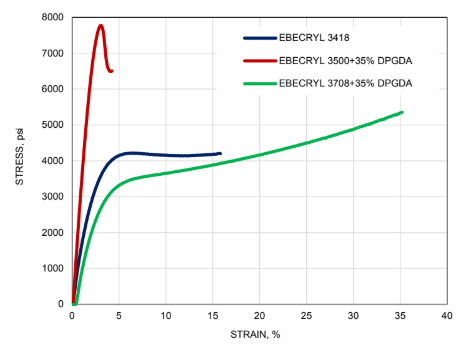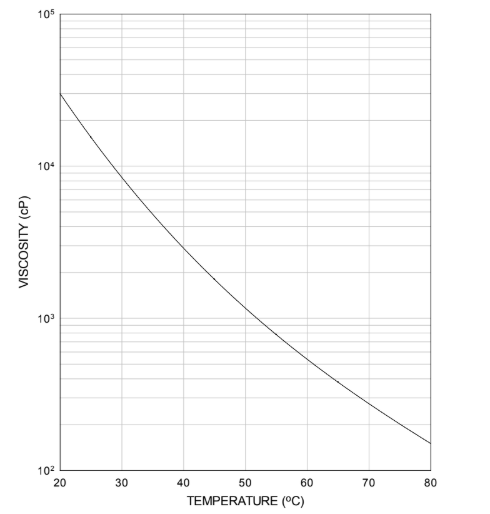Enhanced TDS
Identification & Functionality
- Blend
- No
- CASE Ingredients Functions
- Chemical Family
- Function
- Monomer
- Product Code
- MITM00380
- Single Ingredient
- Yes
- Technologies
- Product Families
Features & Benefits
- CASE Ingredients Features
- Product Benefits
- Reduced viscosity
- Excellent UV/EB cure response
Applications & Uses
- Application Method
- Coating End Applications
- Compatible Substrates & Surfaces
- Cure Method
- Markets
- Applications
- Product Applications
- Wood topcoats and sealers
- Clear coatings for paper, and flexible and rigid plastics
- Resilient floor coatings
Properties
- Physical Form
- Product Properties
- High flexibility
- Good chemical resistance
- High gloss
- Toughness
- Excellent adhesion to most types of wood and many plastics
Technical Details & Test Data
- Stress-strain Properties
Graph I compares the stress-strain curves of UV cured free films of EBECRYL® 3418 with the modified bisphenol A epoxy epoxy acylate oligomers, EBECRYL® 3500 and EBECRYL® 3708. For proper comparison, the EBECRYL® 3500 and EBECRYL 3708 were combined with 35% by weight DPGDA.
Stress-strain Curves of Modified Bisphenol a Epoxy Acrylates

Graph II illustrates the change in viscosity of EBECRYL 3418 with increasing temperature.

EBECRYL® 3418 - Viscosity vs. Temperature- Technical Data
Viscosity Reduction
- EBECRYL® 3418 can be combined with reactive diluents such as dipropylene glycol diacrylate (DPGDA) 1,6-hexanediol diacrylate (HDDA)(1), isobornyl acrylate (IBOA), and trimethylolpropane triacrylate (TMPTA).
- Although viscosity reduction can be achieved with non-reactive solvents, reactive diluents are preferred because they are essentially 100 percent converted during UV/EB exposure to form a part of the coating or ink, thus avoiding solvent emissions.
- The specific reactive diluents used will influence performance properties such as hardness and flexibility.
Packaging & Availability
Principal Information
- Group Principal Number
- S000001
- Principal
Storage & Handling
- Storage Conditions
- Care should be taken not to expose the product to high temperature conditions, direct sunlight, ignition sources, oxidizing agents, alkalis or acids.
- This might cause uncontrollable polymerization of the product with the generation of heat.
- Storage and handling should be in stainless steel, amber glass, amber polyethylene or baked phenolic lined containers.
- Procedures that remove or displace oxygen from the material should be avoided.
- Do not store this material under an oxygen free atmosphere.
- Dry air is recommended to displace material removed from the container.
- Wash thoroughly after handling.
- Keep container tightly closed.
- Use with adequate ventilation.
Other
- Appearance
- Clear liquid
- Appearance (SDS)
- Clear to hazy liquid
- Color (SDS)
- Yellowish
- Insoluble in (SDS)
- Water
- Item Number
- Odor (SDS)
- Ester
- Other Hazards
- Polymerization may occur from excessive heat, contamination or exposure to direct sunlight .
- Protect from Freezing
- Yes
- Temperature Control
- Yes
- USA/DOT UN Number
- Not Applicable
- Material Composition
Value Units Test Method / Conditions Oligomer Content 65.0 %(W/W) %(W/W) - Mechanical Properties
Value Units Test Method / Conditions Elongation at Break 15.0 % % UV cured, 125µm thick films Tensile Modulus 184000.0 psi psi at break, UV cured 125 μ thick films Tensile Strength 4067.0 psi psi at break, UV cured 125 μ thick films - Optical Properties
Value Units Test Method / Conditions Color Scale max. 3.0 Gardner Gardner Gardner Color Scale - Physical Properties
Value Units Test Method / Conditions Density 1.12 g/mL g/mL at 25°C Storage Temperature 39.2-104.0 °F °F Viscosity 10000.0-25000.0 mPa.s mPa.s at 25°C - SDS Physical and Chemical Properties
Value Units Test Method / Conditions Boiling Point (SDS) min. 100.0 °C °C Density (SDS) 1.12 g/cm³ g/cm³ Flash Point (SDS) min. 100.0 °C °C Vapor Pressure (SDS) max. 1.33 hPa hPa at 20°C Volatile Content (SDS) max. 0.5 % % - Shelf Life & Stability
Value Units Test Method / Conditions Shelf Life 0.0 d d
